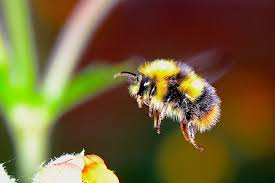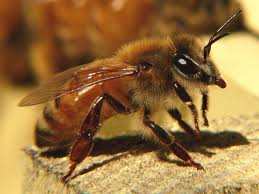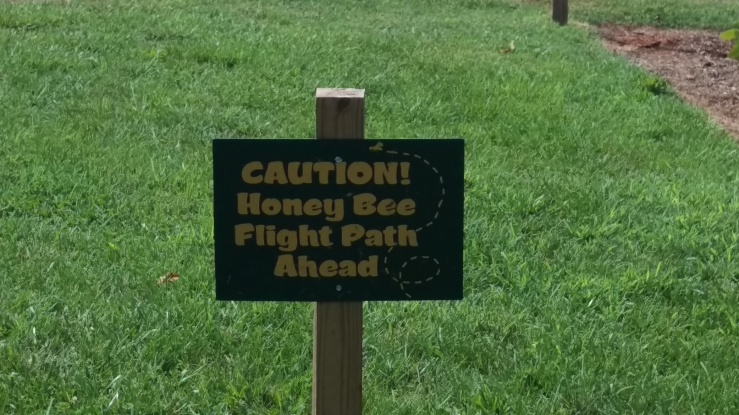 Yesterday morning, my husband and I were sitting by the hotel pool. We had just finished our swim and were enjoying the mild sunshine and low humidity as we waited for our lunch to arrive. As he looked up, my husband said “That bee just dove into the pool.”
Yesterday morning, my husband and I were sitting by the hotel pool. We had just finished our swim and were enjoying the mild sunshine and low humidity as we waited for our lunch to arrive. As he looked up, my husband said “That bee just dove into the pool.”
“Go find a net or something to fish him out,” I said. My husband wandered around the pool looking for something to save the bee.
Meantime, the bee was moving toward the side of the pool with with surprising speed and steadfast purpose. He looked like he was swimming. Was he doing the thorax stroke or the wing over wing crawl?
As he got closer to the side of the pool, I reached over with the plastic-coated menu and fished him out. Before I could lift the menu high enough to let him crawl off it, the large fuzzy bumble bee flew off. I have never seen a bee that resilient. Somehow I have a feeling this was not his first dip in the pool.
The last time I had experienced a bee and liquid was when a another large bumble bee flew into my glass of chardonnay several years before. He must of gotten a good sip before we fished him out with a spoon. He acted quite buzzed and staggered around for several minutes on the concrete before finally flying off in a very zigzag pattern.
 Today, we were at the Market at Grelen and I had another indirect bee experience. I saw this captivating sign near their flower garden. “Caution! Honey Bee Flight Path Ahead” Although I didn’t get to see any actual honey bees I was totally beguiled by the sign.
Today, we were at the Market at Grelen and I had another indirect bee experience. I saw this captivating sign near their flower garden. “Caution! Honey Bee Flight Path Ahead” Although I didn’t get to see any actual honey bees I was totally beguiled by the sign.

My recent bee experiences reminded me that these pollinators are in danger. Pesticides and habitat loss are among the reasons that bee and butterfly populations are declining. According to Justin Worland in March 2, 2017 Time article, “More than 700 North American Bee Species are Headed Toward Extinction.”
The pollinators are responsible for a lot of the world’s agriculture. Without them, many of the plants we have now would not be possible. According to Fox news, “The honey bee is the only insect that produces food eaten by humans. The species can pollinate over 75 percent of flowering plants and crops, making it one of the top pollinators in the U.S. That means the bee can travel up to 6 miles a day and pollinate between 50 to 100 flowers per trip. The pollination process occurs when the pollen sac from one flower sticks to a honey bee’s legs and is transferred to another plant. The pollen within the sac spills out when the bee lands on the plant, causing it to be fertilized.”
What c an we do to help save the bees? Some suggestions include planting Bee friendly trees and plants. Some plants bloom in the spring or the fall. Other plants bloom all summer. Don’t use pesticides in your lawn. Support your local beekeeper by buying local honey. Provide a small dish of water for the bees to drink from.
an we do to help save the bees? Some suggestions include planting Bee friendly trees and plants. Some plants bloom in the spring or the fall. Other plants bloom all summer. Don’t use pesticides in your lawn. Support your local beekeeper by buying local honey. Provide a small dish of water for the bees to drink from.
What are you doing to help save pollinators? Join in the conversation on what you are doing to save the bees, butterflies, and bats that we depend upon to keep the plants going that we need for both food and beauty? We truly are all in this together.



This falls into the grand category that organizational developers call the Law of Unintended Consequences, reflected in several of what Peter Senge (“The Fifth Discipline”,, Doubleday, New York, 1990) referred to as the Laws of the Fifth Discipline. Among the ten that Senge codfied::
** Today’s problems come from yesterday’s “solutions”.
** The cure can be worse than the disease.
** Cause and effect are not closely related in time and space.
** There is no blame.
Large scale systems are commonly complex enough that it is virtually impossible to understand fully how their parts interact, especially given that interactions take place at different scales and over different periods of time. We’re doomed to a life of endless tweaking, each time hoping that today’s “improvements” don’t create unexpected results later. But they always do.
That’s not a warning to avoid tinkering. Progress depends on making changes and learning from them. The Law of Unintended Consequences just assures that we will always have more to learn.
LikeLiked by 2 people
Hi Rolig, I love this comment about unexpected consequences. I also appreciate learning about the book and author. Thanks for continuing to add to my store of knowledge.
LikeLike
One of the interesting writ-up i have come across. Being humorous at the same time raising the alarm. ⭐
LikeLiked by 2 people
Sharing it on my blog. It is one of the biggest concerns but lesser known
LikeLiked by 2 people
Glad you like the post. Thank you very much for the compliment of sharing it on your blog.
LikeLiked by 2 people
It is big concern but less awareness. Glad to have come across your post
LikeLiked by 2 people
Reblogged this on In the World of Thoughts and commented:
There hss been awareness in recent times on the extinction of bees, their importance as pollinators.
This writ-up is quite informative at the same time quite amusing ⭐
LikeLiked by 2 people
Reading this post and passing the information on.🐝🐝🐝🐝🐝 Thank you for sharing.
LikeLiked by 2 people
Thank you Mr. Mel. Glad you liked the post and are going to pass it on. The bee emojis are perfect.
LikeLike
I’m glad your swimming bee had a happy ending 🙂 The bees seem to love the wildflowers in my front yard and the lavender in the back.
LikeLiked by 2 people
I concur with the bees. I love lavender and got to visit a certified lavender farm outside San Diego. May be as close to Provence as I ever get.
LikeLiked by 2 people
I concur with the bees ok the flowers.
LikeLiked by 2 people
Reblogged this on Mick E Talbot Poems.
LikeLiked by 1 person
Thank you for the compliment of sharing this blog post on your site. Love your poems.
LikeLiked by 1 person
A good article on bees and their problems, wondering if you noticed the absence of common wasps in your area, (or not)?
LikeLike
thanks for the appreciation re my poems 🙂
LikeLike
The late spring frosts killed off the queen wasps, and probably a lot of bumble queens too, the latter definitely not been as abundant in my garden compared to previous years. Honey bees at the moment abundant on a largish stand of flowering mint, along with hovers and green bottles in their hundred. Fickle weather, in my opinion, is definitely a serious problem for most invertebrates. However going back to the honey bees re. the late frosts; the chances of them suffering slight, for obvious reasons.
LikeLiked by 1 person
We just moved here last Spring and I haven’t noticed any wasps. Not sure what the norm is for this part of Central Virginia.
LikeLiked by 1 person
Anon………..
LikeLike
Onward and upward–may the wasp be with us.
LikeLiked by 1 person
Some wonderful ideas there on how to make your garden more bee-friendly. Great ideas! They need all the help we can give them.
LikeLike
Very true. This is an international problem I think.
LikeLike
[…] pictures) so it would be simpler for the prospective reviewers. The sample blogs included Too Bee or Not Too Bee (August 26, 2017), Uncivil Rights (February 25, 2017), and Taking Books to the People, Part 1: […]
LikeLike